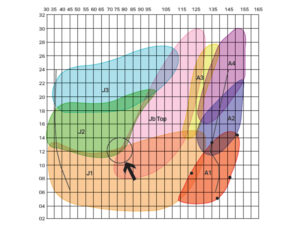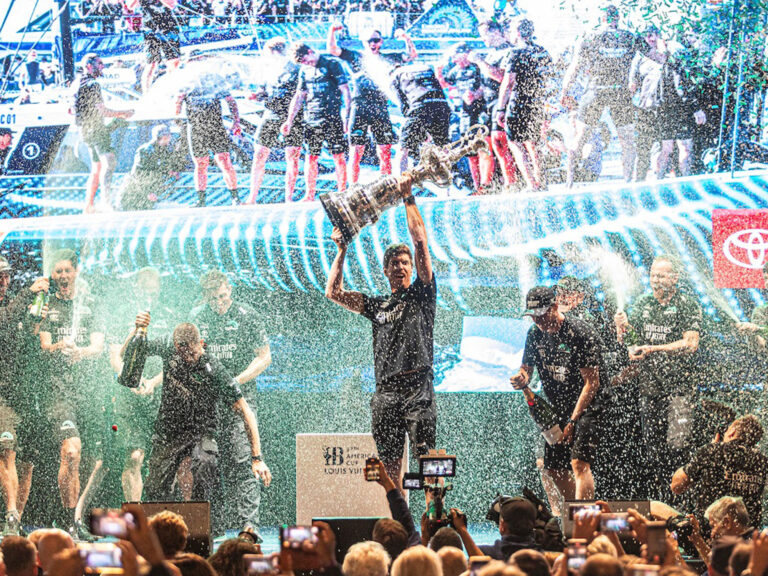
Advantage Gate
There are three kinds of sailboat races-ones so short that the advantaged side doesn’t matter, ones so long that the advantages tend to even out (or other factors are equally or more important), and races of medium length in which getting to the advantaged side is paramount. On medium-length courses, which are typically set near shore, there’s usually an advantaged side. The first boat to reach the advantage usually wins, because after it does, there’s insufficient time remaining for anyone to catch up.In big fleets sailing long courses, the best strategy is to start in the middle of the line, keep to the middle of the course, expect that any advantage to one side (unless extreme) will be reversed by some advantage to the other, presume that boatspeed will get you into the top 10 at the weather mark, and await the mistakes of your opponents.In small fleets on short- to medium-length courses, the opposite is true. Here, the best approach is to start at the extremities of the line, head immediately toward the advantaged side, and realize that boatspeed is of little value unless you get to the advantage first.
One side is almost always advantaged, either because of a persistent shift, the onset and subsequent veering of a sea/lake breeze, the dominance of a particular phase of a series of oscillating shifts, by favorable current, stronger wind, or smaller waves. Before the start, the competitor must evaluate the conditions and decide, not whether, but which side is advantaged and then develop a plan to get to that side first.Essentially, this means that you must start at one of the extremities of the line-to leeward of all other boats heading left when the left side is advantaged, or to windward of all other boats with the ability to be the first to tack to port when the right side is advantaged. However, such perfect starts require precise timing and positioning and all too often a small mistake results in being driven through or over. Alternatives are available.What matters most is getting to the advantaged side of the course before your opponents, not necessarily getting off the line first. The first step at about one to one and a half minutes before the gun is to sail into a position, either beyond the advantaged end or to the advantaged side of the fleet, from which it can be observed as it organizes for its final approach. From such a position, it will quickly become evident to which end of the line most boats are headed and whether most of them will be early or late. Perhaps everyone will act in accordance with Yogi Berra’s presumption that “the place has become so crowded that no one goes there any more” or in light air will be unable to reach the desired end in time.
Opportunities to make the perfect end start may then become evident and should be utilized.There are two special circumstances in which this perusal will reveal such an opportunity: when the opposite end of the line is more upwind and will attract most of the fleet, and in strong current. A tack below the most leeward boat on the line when the right end of the line is more upwind, but the left side is advantaged or a position above the most windward boat on the line when the left end is more upwind, but the right side is advantaged is usually possible. In favorable current, seek the pin end from a position below the layline. In unfavorable current, approach the weather end from a barging position.If the pin end is upwind and the left side of the course is advantaged, you should arrive at a location a few boat lengths beyond the pin and just below the extension of the line with about one minute to go. Try to be the last boat to come back on port, because if you’re not, you’ll be controlled by the one that is. From here, if the air is light and the fleet late, one may bear away on port, cross ahead, and tack in clear air to windward. If the fleet is on time or slightly late, you can cross below the pin with about 20 to 30 seconds remaining, tack under the leading starboard tacker, luff them if necessary (after completing your tack), and bear away to arrive at the pin with the gun. Vary the radius of your circular approach to the first starboard tacker so that at the tack’s completion you are bow to bow with them. If the fleet is early, you should bear away at high speed below the first few boats, find a hole, tack into it, and come up tight under the boat to windward.
Sometimes, if the pin end is heavily favored, boats will be tacking to port as soon as the gun fires. Your speed will permit you to slide through the hole that one of them creates and to emerge and tack in clear air to windward of boats hung up at the pin.If the weather end is upwind and the right side of the course is advantaged, two alternatives to approaching on starboard and arriving at the committee boat on time are available. One is to approach from the port end (just as you would have done if the pin end were favored) but timed so that you arrive close to the weather end 20 to 30 seconds before the gun. From here, you should tack under the most leeward of the starboard tackers that is luffing up to the line. Come in late with speed; arriving early will permit some of the boats to windward to escape and go around you to leeward. After completing your tack, you should luff the most leeward boat, initiating a chain reaction that will affect most of the boats near the layline, and cause them to slow for fear of being shut out at the committee boat. You should then be the only boat in the vicinity that can bear away, get up to speed as the gun fires, and tack across the bows of those boats jammed astern and to windward.The other, safer alternative is to make a late start, but do so right at the committee boat.
At about one minute before the gun, take a position from which the fleet can be observed four to six boatlengths beyond the weather end and just below an extension of the line. If the fleet is late or excessively slowed by a lull or adverse current, you may be able to slide around the committee boat ahead of them. If they’re early, but moving quickly, the’ll have to bear away down the line, leaving you a hole at the gun. If they’re on time, you should delay and bear away so that you come in with speed right on the transom of the most windward boat. From this position, you should be able to prevent that leeward boat from tacking and be the first to tack yourself.There are two caveats to remember, however: 1. If you come into your final approach late with speed, arrive early, and are forced to slow down, someone with speed will surely drive through, above, or below, and you’ll be in their dirty air all the way to the advantage and beyond. 2. Do not persist in your starting plan when another boat-beyond the port end or ready to barge-is attempting the same start. Keep to leeward and in control of them and be willing to go farther down the line or farther astern, if necessary, to avoid a catastrophe.









